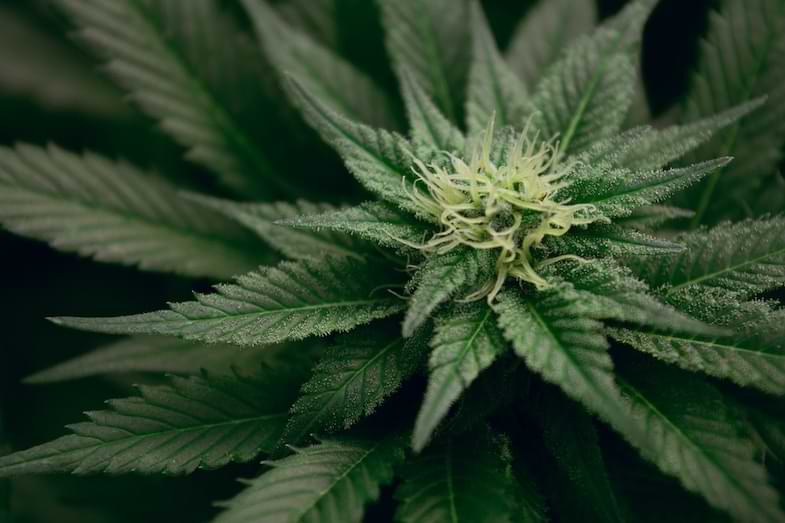Modified on: 19/11/2024
Cloning a cannabis plant: here’s what you need to know
The cloning of cannabis plants is one of the most fascinating and useful procedures for experienced growers. With this technique, we are able to preserve the exceptional characteristics of a mother plant and transfer them into new seedlings, achieving amazing results.
If you are intrigued by the science behind the creation of genetically identical plants, then you have come to the right place. This article will provide you with a detailed guide to cloning a cannabis plant, explaining step-by-step how to carry out this process successfully, guaranteeing a future of astounding cultivation.


How does cloning work?
Taking a cutting from a female cannabis plant will, in the growing phase, produce cannabis plants that are exactly the same as her, equal.
This process passes on to the cloned plant all the characteristics of the mother plant, aromas, flavours, leaves, generating true sister plants.
How do you take a cutting?
A cut is made of a portion of a branch from the plant from which we want to clone. At the cut, a rooting stimulus is performed, using inert material or rooting powder, prompting it to create a new root system.
What is needed to set the process in motion is:
- A healthy cannabis plant, well-sharpened scissors or shears
- Substrate such as rockwool
- Clay to allow the root part to grow
- Rooting gel or powder
- A lighting system suitable for growing the seedlings generated by the cuttings
- Alcohol to clean the tools after cutting
The best thing would be to set up a real indoor greenhouse, like a grow room, in order to reproduce the ideal microclimate for our clone plants. It is good to keep the temperature high and the humidity level balanced.
Another good habit is to spray the cuttings throughout the day. The ideal microclimate of the grow box to encourage cuttings to grow is 25 degrees. By keeping the ecosystem balanced, our light cannabis plants will grow more luxuriantly and quickly. Cloning kits with internal temperature regulators are available in physical shops and online.
But let’s dig deeper.
Read also: How is cannabis grown? A step by step guide
Cloning cannabis guide
Select a mother plant, i.e. the plant you choose to clone and reproduce its genetics: choose the plant well, it must have unique characteristics that can be passed on to future generations.
After examining all the characteristics, we always try to choose the plant with unique characteristics. For example, choices should be aimed at plants with more vigorous growth, accelerated flowering or higher potency.
Obtaining the right tools is essential: well-sharpened and sterile scissors, a rooting gel product, a rooting medium and a small greenhouse. You can also use scalpels or razor blades. Usually, however, the simplest things also prove to be the safest.
Then, cut off a portion of a branch: use scissors to cut off a healthy branch of the adult mother plant. Clean the branch so that you get a single portion. A small trick is to increase the air circulation of the mother plant by cutting off the lower branches. These branches are perfect for cloning, so do not throw them away.
They are the oldest portions of the plant and tend to root faster.
The next step is to clean up the cuttings taken, which consist in cutting off the lower excess leaves.
The cuttings should be about 10 cm long – this size is easier to manage within a mini-greenhouse. The aim is to make a clean cut at a 45-degree angle, so as to increase the surface from which the roots will emerge Quickly dip the freshly made cutting in rooting gel and leave it submerged for about 3 seconds.
Place the cutting in the substrate for rooting: make a small hole in the soil of the pot with a pencil or nail. Make sure it is moist and placed inside a mini-greenhouse. Plant the clone carefully in the hole and press the soil around it gently, if it needs it you can add water.
Finally, remove excess leaves: only one third of the branch portion should have leaves. By now we are talking that it is no longer a branch but a cutting, a small plant ready to start its own growth. In 1-3 weeks you should see the first roots. This is the most commonly used technique for cloning cannabis.


The importance of lighting
We must emphasise the importance of lighting in the grow room to promote the growth of our seedlings. When clones are generated, there will need to be a period of absence of light. Various types of light for indoor growing are commercially available: LED, MH HPS, Grow Led, Plasma Lamps.
Experienced growers and passionate amateurs clash ideologically on the practices regarding light cycles for cuttings and cloning hemp plants.
One party talks of 24 hours of light, while others argue that 18 hours is ideal for lush growth, because in the six-hour dark phase there is a proper resting period for the seedlings.
When the roots of the cuttings emerge from the peat or rockwool substrates, they can be transplanted into potting soil. It is good in this case to fertilise the water that is used for nebulisation, to give strength and stimulate the growth of the seedlings.
On whether or not to use rooting powder, the advice is not to overdo it to avoid over-stimulating the roots, given the delicate nature of cannabis seedlings during the germination period.
Two or three days before flowering is ideal for taking cannabis cuttings. The growing period can last a few days, or several weeks, depending on the nature of the plant from which the portions that are to generate clones are taken.
Read also: Does CBD oil go bad?
Conclusions
In conclusion, cloning cannabis plants is a widely used and effective method for reproducing the genetics of a desirable mother plant. Through this process, growers can create exact replicas of the original plant, preserving its unique characteristics, aromas, and flavors. To successfully clone a cannabis plant, it is essential to follow a few crucial steps.
Firstly, selecting a healthy and robust mother plant with desirable traits is fundamental. Once the ideal plant is chosen, a cutting is taken from one of its branches. This cutting is then treated with a rooting gel or powder and placed in a suitable substrate, such as rockwool, to encourage the development of a new root system. Maintaining the right environmental conditions, including temperature and humidity, is vital for the successful growth of the clones.
Proper lighting is also crucial during the cloning process. Experienced growers have different opinions regarding light cycles for cuttings, but either 18 or 24 hours of light is generally used to promote vigorous growth.
As the clones develop roots, they can be transplanted into potting soil and gradually introduced to a fertilized water supply to strengthen their growth. It is important not to over-stimulate the delicate roots during this stage.
In conclusion, cloning cannabis offers cultivators an efficient way to propagate plants with specific and desired traits, ensuring a consistent and reliable harvest. With attention to detail and care, successful cloning can lead to a bountiful yield of healthy and genetically identical cannabis plants.
💡Takeaways on cloning a cannabis plant
- Cloning a cannabis plant is a method of obtaining plants that are exactly identical to the parent plant, inheriting all its characteristics, such as aroma, flavour and leaf shape.
- The cloning of a cannabis plant is done by taking a cut from a female mother plant during the growth phase. This cut, known as a ‘clone’, will share all the characteristics of the mother plant, resulting in identical sister plants.
- To clone a cannabis plant, a portion of a branch of the desired mother plant must be cut. A rooting stimulus, such as a rooting gel or powder, is applied to this cut to encourage the development of a new root system.
- To begin the cloning process, you need a healthy cannabis plant, well-sharpened scissors or shears, a substrate such as rockwool, clay to facilitate root growth, rooting gel or powder, a suitable lighting system for the seedlings generated by the cuts, and alcohol to clean the tools after the cut.
- Light is essential to encourage the growth of cloned seedlings. After generating the cuttings, a period without light must be provided. In the grow room, various types of lights are available for indoor cultivation, such as LED, MH, HPS and plasma lamps.
- The choice of the mother plant is crucial; you must opt for a plant with unique characteristics that you wish to replicate in future generations.
- Use well-sharpened and clean tools, as well as rooting products and a small, protected environment to encourage cutting growth.
- Ideal conditions of temperature and humidity will help the seedlings to grow quickly and luxuriantly.
- A light cycle of 18 or 24 hours can be adopted for cuttings, depending on grower preference and experience. It is advisable to provide a period of darkness to allow the seedlings adequate rest.
- Continuous and adequate care during the growing process of cuttings is essential to obtain healthy and vigorous cannabis plants.
FAQ on cannabis cloning
How does the cloning of cannabis plants work?
Cloning of cannabis plants is a process by which an exact copy of a parent plant is created. This is done by taking a cut or ‘clipping’ from a healthy, mature female plant during the growth phase. The cut is taken from a side branch or part of the plant from which you wish to clone. Once the cut is taken, it is treated with a rooting substance, such as gel or powder, in order to stimulate root growth. Next, the cutting is planted in a suitable substrate, such as rockwool or potting soil, to develop a new root system.
During the cloning process, all genetic traits of the mother plant are passed on to the cloned plant, including aromas, flavours, leaf shapes and physical characteristics. This means that the cloned plants will be exactly identical to the mother plant, generating a ‘family’ of plants called ‘sisters’.
Cloning is a common and reliable method of propagating and maintaining the desired characteristics of cannabis plants, especially when one wishes to replicate the particular qualities of a plant with certain exceptional characteristics.
What are the main steps in taking a cut for cloning?
To take a cutting for cloning a cannabis plant, it is important to follow a few basic steps. Initially, you must select a healthy, well-developed mother plant, preferably one with unique and desirable characteristics that you wish to perpetuate in the cloned plants.
After locating the mother plant, use scissors or well-sharpened shears to carefully cut off a portion of a side branch. This cut should be about 10 centimetres in length, as smaller dimensions facilitate management within a mini-greenhouse or mini-greenhouse.
Once the cut has been made, the cut itself is cleaned by removing excess leaves from the underside of the cut. This will help focus the energy on root growth.
The next step is to apply a rooting substance, such as a rooting gel or powder, to the underside of the cut. This helps stimulate root growth and increases the chances of successful cloning.
Finally, the cutting is planted in a suitable substrate for rooting, such as rockwool or potting soil. It is essential to maintain a moist and warm environment to encourage root development.
What are the important factors to consider during the cloning process of cannabis plants?
During the process of cloning cannabis plants, there are several important factors to consider to ensure the successful propagation and healthy growth of cloned plants.
- Selection of the mother plant: Choosing a healthy and robust mother plant is essential for obtaining quality clones. The mother plant should have desirable characteristics, such as excellent resin production, pleasant aroma profiles and vigorous growth.
- Tools and hygiene: Ensure that the tools used to take cuts are sharp and sterile. This will reduce the risk of infection or disease that could damage the cuttings and hinder root growth.
- Rooting substances: The use of rooting gels or powders can help promote rapid root formation in cuttings. However, it is important not to overdo the amount of rooting substance to avoid over-stimulation problems.
- Environmental conditions: Providing a warm, moist environment is crucial for successful cloning. The use of mini-greenhouses will help to maintain the ideal humidity and temperature for root formation.
- Lighting: During the initial cloning period, cloned plants require proper lighting. It is advisable to use a low-energy light or LED with a light cycle of 18 hours per day to promote healthy growth.
- Care and monitoring: During the rooting period, it is important to carefully monitor the cuttings and ensure proper care. Keep the substrate moist and protect the cuttings from temperature fluctuations or excessive exposure to light.
- Transplanting and adaptation: Once the cuttings have developed strong roots, they can be transplanted into larger pots or into the ground. During the adaptation period, it is important to provide adequate support to avoid damage to the growing roots.









